As I explained in a previous article about Saint Sylvester and the Dragon, much medieval and Renaissance European religion art is based on Christian legends which are not found in the Bible. These include stories of the saints, and also stories taken from books of the Bible which are non-canonical, or which are labeled as “apocryphal” and not printed in most Protestant Bibles, although they might be found in Catholic or Orthodox Bibles. In this article, I would like to consider the “Harrowing of Hell” in which Jesus travels into the underworld to rescue the souls imprisoned there in order to lead them to paradise. This is an example of a story which is better known in its many visual representations throughout the medieval churches of Europe than in any written narrative form.
The Biblical basis for the story is scanty indeed. The descent of Jesus into the underworld forms part of the ancient Apostles’ Creed, where Jesus is said to have “gone down to those beneath” (Latin, descendit ad ínferos). There is a Biblical echo of this statement in Ephesians 4:9: “he descended into the lower parts of the earth” (Latin Vulgate, descendit in inferiores partes terrae). The Latin adjective inferus simply means “lower, below, underneath,” as you can see in the English word “inferior.” Yet in ancient Roman culture, the “underneath world” was already regarded as the abode of the dead, so that the plural form of the adjective, inferi, often stood simply for “the dead.” In English, this same Latin root even gives us the word “inferno,” which has lost its sense of “below,” and instead now refers to any kind of terrible “fire,” not limited to the fires of hell.
The fullest written account of the “Harrowing of Hell” is not found in the Bible, however, but in the non-canonical Gospel of Nicodemus, a text which probably dates back in some form to around the 3rd century or even earlier. Here we read how Jesus, after his crucifixion, descended into hell and brought salvation to the souls of the dead who were prisoners there. The story begins with a dialogue between Hades and Satan, who have heard word that Jesus is coming, which prompts a debate about the power of Jesus. Hades is afraid, because he has heard of the miracles Jesus has performed on earth. Satan, on the other hand, has heard that Jesus was crucified as a common criminal; he is certain that they will be able to bind and subdue Jesus when he arrives in their realm.
When Jesus arrives, Hades bids his servants to bolt and lock the doors, but to no avail; Jesus shatters the gates and enters. He seizes Satan and binds him in iron chains, then consigning him into Hades’s keeping until the second coming. Jesus next turns his attention to the patriarchs. He raises up Adam, along with all the prophets and the saints. Together, they all depart up out of Hades, and ascend into Paradise. (You can read a full account in the Gospel of Nicodemus online.) The “Harrowing of Hell” portion of that Gospel was widely circulated in other compilations of religious literature, most notably in the Golden Legend of the lives of the saints, compiled by Jacob of Voragine in the 13th century.
The literary versions of the “Harrowing of Hell” in turn gave rise to many works of art, including the “mystery play” tradition of medieval religious drama. Most commonly, however, people would learn about Jesus’s descent into the underworld from the artwork which decorated the churches and cathedrals of Europe. In the remainder of this article, I would like to look at ten different visual depictions of the story, to see what details we can observe in each artist’s rendering of the scene.
Let’s start with a modern Orthodox icon. In this very simple depiction, Jesus has broken through the doors to hell which he tramples underfoot (notice the locks all broken asunder), and he rescues Adam and Eve. As often, Adam is shown as an old man, while Eve is young. The traditional name for this scene in the Orthodox tradition is the “Anastasis,” the “Raising Up” as you can see written in the icon itself:
 Anastasis (modern Greek Orthodox icon) | View larger image »
Anastasis (modern Greek Orthodox icon) | View larger image »
While Adam and Eve are clothed in this icon, they are often shown in the nude, as in this 15th-century wood carving, late 15th century by Veit Stoss from the Mariacki Altarpiece in Cracow, Poland. Notice also here the presence of demons, who are tormenting the dead:
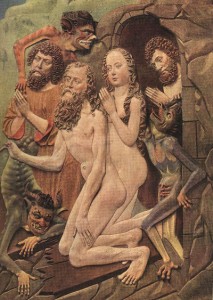 Detail of the High Altar of St Mary, c. 1477-1489
Church of St. Mary, Cracow | View larger image »
Detail of the High Altar of St Mary, c. 1477-1489
Church of St. Mary, Cracow | View larger image »
To emphasize that he has only lately been crucified, some depictions emphasize Christ’s wounded hands and feet, as in this 16th-century painting now housed in the Museum of Lille:
 16th-century painting (Musée des Beaux-Arts, Lille) | View larger image »
16th-century painting (Musée des Beaux-Arts, Lille) | View larger image »
While Jesus is often shown trampling the doors to hell underfoot, sometimes he is trampling a demon underfoot, as in this early 14th-century sculpture. Notice also how the scene is paired with the entombment of Christ to the left:
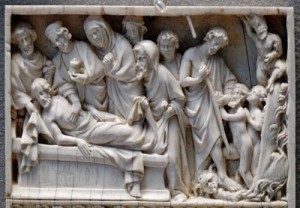 14th-century sculpture (now in the Louvre Museum, Paris) | View larger image »
14th-century sculpture (now in the Louvre Museum, Paris) | View larger image »
Some depictions combine both the door underfoot and the demon, as in this marvelous piece of 15th-century stained glass in the Church of St. Ethelbert, Hessett, Suffolk. Notice the flames licking out from under the door!
 Stained glass from Church of St. Ethelbert, 15th-century
Hessett, Suffolk | View larger image »
Stained glass from Church of St. Ethelbert, 15th-century
Hessett, Suffolk | View larger image »
In addition to the demons you might see trampled underfoot or harassing the dead souls, you can also find demons standing off to the side, observing the events, as here in Andrea da Firenze’s famous 14th-century fresco from Santa Maria Novella in Florence, Italy. Here you can see Jesus rescuing a whole crowd of souls from the underworld:
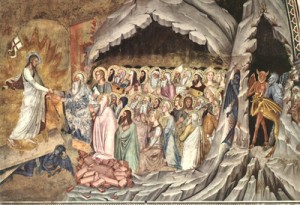 Fresco by Andrea da Firenze, 14th century
Santa Maria Novella, Florence, Italy | View larger image »
Fresco by Andrea da Firenze, 14th century
Santa Maria Novella, Florence, Italy | View larger image »
Here is a detailed view of those demons as they watch the proceedings:
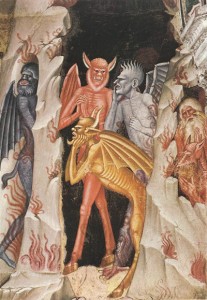
Another character who often figures in representations of the harrowing of hell is the “good thief,” Saint Dismas, who was crucified with Jesus. Jesus promises Dismas that “today you will be with me in paradise” (Luke 23:43). Not surprisingly, then, Dismas is also seen journeying with Jesus down into the underworld on their way to paradise. For example, you can see Dismas standing behind Jesus in this woodcut from 1510 by Albrecht Durer:
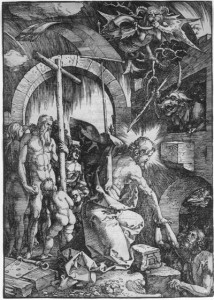 Woodcut Albrecht Durer, 1510 | View larger image »
Woodcut Albrecht Durer, 1510 | View larger image »
If you look carefully behind Adam and Eve, you can see Dismas bearing the cross in this mosaic from the Church of San Marco in Venice:
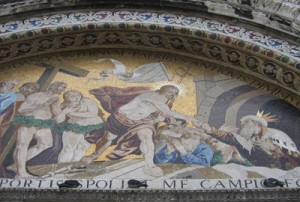 Mosaic, Church of San Marco (15th-century)
Venice, Italy | View larger image »
Mosaic, Church of San Marco (15th-century)
Venice, Italy | View larger image »
Sometimes Jesus is also accompanied by angels who battle the demons as he leads the soul out from their captivity, as in this painting by Tintoretto from 1568:
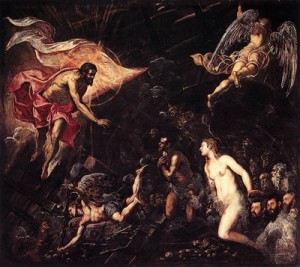 Painting by Tintoretto, 1568 | View larger image »
Painting by Tintoretto, 1568 | View larger image »
As you can see from the quite attractive nude depiction of Eve in Tintoretto’s painting, the story of the Harrowing of Hell provided Renaissance artists a rare opportunity to paint female nudes in a work of religious art. This is carried to extremes, as you can see, in Bronzino’s elaborate crowd scene, painted in 1552 and found in the Refectory of Santa Croce in Florence:
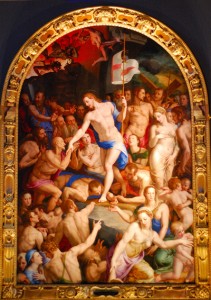 Painting by Bronzino, 1552 | View larger image »
Painting by Bronzino, 1552 | View larger image »
Refectory of Santa Croce, Florence, Italy (source)
You will observe a remarkable contrast if you compare Bronzino’s R-rated scene to the extremely modest Orthodox icon with which we began this survey, an admittedly brief survey which only begins to hint at the wide range of iconographic styles in which this story has been depicted. As Jesus makes this underworld journey in the imaginations of these many artists over the centuries, he joins the ranks of heroes such as Orpheus and Heracles who also journeyed into the realms of the dead, breaking down the doors between that world and this one in order to rescue the souls who have been imprisoned on the other side. Although this is a not a story about Jesus that you will read about in the Bible, it is nevertheless a very famous one, as told both in words and, even more importantly, in images.

Hello,
You have used my picture from Flickr, the beautiful painting by Bronzino for this online magazine, which I like by the way without getting my permission. All rights on my work are reserved. I should have been notified first. You can leave it now but you should check the licenses people use for their photos.
Thanks,
Cate
My apologies, Cate – for an academic review article of this sort, I thought that a link back to the original source for the image would be sufficient, given the academic fair use of images, especially smaller images which are linked to the full-size view of an image that is freely available for all to see elsewhere online. If you would prefer that the image be removed so that only the link to the image remains, please just say so; you certainly sound very unhappy about this, and it is no problem at all to remove the image entirely, leaving only the link to the image which you published online. If that would make you happy, please say so!
Cate – I’m glad you like the site! The painting by Bronzino is indeed beautiful.
As I understand copyright law in the United States and in many other countries, mechanical reproductions (including photographs) of two-dimensional works of art do not have copyright protection: if someone takes a picture of flat art in the public domain, the flat photograph is also in the public domain. When I included this photo on the site without first requesting permission, I was not simply failing to “check the license” you used for your photo. Rather, I believed (and still believe) that your photo is in the public domain. Is that not your understanding of the applicable laws?
But I do like your idea about notifying people if I use their public-domain photos on the site. It’s not required by any kind of license or copyright law or anything, of course, but I think it would be a nice gesture. I’ll be striving to do that in the future: thanks for the tip!
No Randy this is not the case at all. I have copied from Flickr their explanations of the various licenses. If I would have had the creative commons license then what you have done would be adequate but I do not.
Mine is all rights reserved which is stated in my photo information.
I have published photos in several art history books and they have all contacted me to ask permission. I do not believe this to be in the public domain. I do not allow any downloads of my photos on Flickr. There are many terrible pictures of paintings on the web. It is very difficult to get them true. I am not trying to be difficult but these are the facts.
Thanks
I dug further and I stand corrected Randy. I cannot believe that photographers images of paintings are not protected. Taking museum shots is extremely difficult.
Thanks,
Cate
Cate – Thanks for following up! I’m glad that your research turned up the same results that my research had done: if a two-dimensional work of art is in the public domain, then photographs of it are also in the public domain. I personally cannot believe that there’s a distinction between photographs of two-dimensional works of art and photographs of three-dimensional works of art, but copyright law is a crazy thing.
This is an interesting dialogue although the subject matter of the inexorably voluptuous Bronzino is obviously more interesting.
The Bridgman Art Library syndicates my images. Recently I put this question to Adrian Gibbs one of the Bridgman curators:
“Who owns the copyright in Michelangelo’s David/ Head of Odysseus/Leonardo Last Supper”
Adrian responded as follows:
“This recently from a lawyer in Rome acting for the ‘Ministerio’:
‘While the majority of the artworks in our state museums may not be protected by artist’s copyright, since almost twenty years access to photographing such artworks has been restricted by law.
As well-known to every fine arts photographer, in 1994 the Italian parliament adopted the so-called Ronchey Act (1993), which, among other issues, governs the reproduction right of every image of works of art owned by the Ministry of Culture: the reproduction of these images is authorized only upon written agreement from the local Superintendant, who manages the state museums in his area, and upon payment of the relevant permission fee.
If the museum can supply a good quality of the work requested, it will add to such permission fee a photographic fee. If not, the museum will authorize the publishers to commission new photography, and any photographer authorized to shoot in a state museum will have obtained a single-use only written authorization. Re-uses of the image would be subject to the applicable permission fee.
Please be reminded that the Italian Ministry of Culture owns works of art in the ownership of 583 state institutions: 133 archives, 47 libraries and, in particular, all 403 state museums, monuments and archaeological sites. It includes world-famous museums as the Galleria degli Uffizi, the Galleria dell’Accademia and Palazzo Pitti in Florence, the Galleria dell’Accademia in Venice, the Coliseum, the Forum, the Terme di Caracalla and the Galleria Borghese in Rome, the Museo di Capodimonte in Naples, the sites of Pompei and Ercolano, the Galleria Sabauda in Turin, the Pinacoteca di Brera in Milan etc.
Licensing the above images without clearing the museum’s authorization consists in a civil law violation, unless the photographer, or his agency, have signed an agreement with the Ministry of Culture including a royalty and specific restrictions for non-editorial uses’.”
When I mentioned Wikipedia this was the response:
“Wikipedia’s stance is an interesting one. They are correct of course in asserting that the work of artists who have been dead for over 70 years is no longer protected by copyright. However your photograph of Michelangelo’s ‘David’ is protected by your copyright. Wikipedia adhere to the belief that photography of 2-D works is not copyright-able. They base their thinking on a court case that we lost ten years ago in NYC. That ruling’s relevance outside the jurisdiction of that particular court is highly debatable but copyright libertarian types cling to it.
The ‘Ministero’ use specific Italian legislation passed in 1994 to assert their control over reproduction of State-owned work and their ability to exploit it commercially. It is a nuisance and we have engaged a Milan lawyer to advise us, but it does look as if we will have to follow the rules”.
Yours sincerely,
André Durand
Twenty-First Century Paintings http://www.andredurand-gallery2000.com
The Wholly Pictures Sussex http://www.durandwhollypictures.com
Twentieth Century Paintings http://www.durand-gallery.com
I think it is a sad day for teachers, like myself, if we are not able to make use of images to convey information. I would certainly be in a sad position myself if all the ancient, medieval, and Renaissance TEXTS I use in my work were all under the control of ministries and museums. Thank goodness no one has managed to take possession of the old words in the way that the old works of art have turned into commodities in the modern age. Last summer I was able to publish and give away for free – http://pdf.bestlatin.net – a collection of 1001 Aesop’s fables in Latin harvested from books published in the 15th, 16th, 17th, 18th and 19th centuries. Public domain is alive and well in the world of printed WORDS, at least.
In any given instance, I am always prepared simply to remove any image for any webpage I have published, although I hope that the notion of fair use can help those of us whose goals are purely educational. That’s where it comes down for me: as I make no money from my web publishing endeavors, I don’t have the means to pay for the re-use of the images that I find already on the Internet, but in situations where the use of those images already on the Internet falls afoul of copyright (and there are many orphaned images on the Internet, of completely unknown status in terms of copyright), or where the use of those images fall afoul of what people think is their copyright, I can simply remove the image. That’s my only option. I’m not sure who gains by that, but it is the only recourse I have as a teacher who puts materials online in the hopes of promoting the public good – and for no other reason.
I respect photographers who are seeking to make a living by means of their art, and if they think it will assist them in their commercial endeavors for me to remove an image from a webpage, I am glad to do so – although I am also glad that in all my years of working with images online, I have only been asked once to remove an image, which I promptly did (while removing at the same time the link I had dutifully made to the website where the artist herself was displaying the same image online in hopes of selling her work). I’m not sure if anybody won anything that way, but I complied immediately with the artist’s request. For me, the images on webpages are always just something extra… and I consider myself lucky indeed that there is a rich and abundant public domain for the world of WORDS, which is what is the real focus of my online publishing endeavors.
cool love the pics.